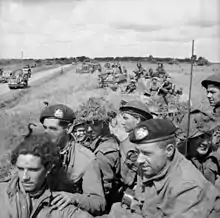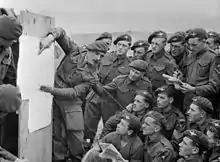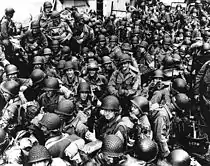List of Allied forces in the Normandy campaign
This is a list of Allied forces in the Normandy campaign between 6 June and 25 August 1944. Primary combat units are listed here; unit articles may contain a complete order of battle.

British infantry the 3rd Monmouthshire Regiment aboard Sherman tanks near Argentan, 21 August 1944

Men of the British 22nd Independent Parachute Company, 6th Airborne Division being briefed for the invasion, 4–5 June 1944


American troops on board a LCT, ready to ride across the English Channel to France. 12 June 1944.
United States
| Unit | Arrival | Beach | Commander |
|---|---|---|---|
| 1st Infantry Division | 6 June | Omaha | Major General Clarence R. Huebner |
| 2nd Infantry Division | 7 June | Omaha | Major General Walter M. Robertson |
| 4th Infantry Division | 6 June | Utah | Major General Raymond O. Barton [lower-alpha 1] |
| 5th Infantry Division | 9 July | Utah | Major General Stafford LeRoy Irwin |
| 8th Infantry Division | 4 July | Utah | Major General William C. McMahon Major General Donald A. Stroh (from 12 July) |
| 9th Infantry Division | 10 June | Utah | Major General Manton S. Eddy Major General Louis A. Craig (from 19 August) |
| 28th Infantry Division | 22 July | Omaha ? | Major General Lloyd D. Brown Brigadier General James E. Wharton (12–13 August) Major General Norman D. Cota (from 14 August) |
| 29th Infantry Division | 6 June | Omaha | Major General Charles H. Gerhardt |
| 30th Infantry Division | 10 June | Omaha | Major General Leland Hobbs |
| 35th Infantry Division | 5 July | Omaha | Major General Paul W. Baade |
| 79th Infantry Division | 12 June | Utah | Major General Ira T. Wyche |
| 83rd Infantry Division | 18 June | Omaha | Major General Robert C. Macon |
| 90th Infantry Division | 6 June | Utah | Brigadier General Jay W. MacKelvie (until early July) Major General Eugene M. Landrum (July) Brigadier General Raymond S. McLain (from 30 July) |
| 2nd Armored Division | 9 June | Omaha | Major General Edward H. Brooks |
| 3rd Armored Division | 23 June | Omaha ? | Major General Leroy H. Watson Major General Maurice Rose (from 7 August) |
| 4th Armored Division | 11 July | Utah | Major General John S. Wood |
| 5th Armored Division | 24 July | Utah | Major General Lunsford E. Oliver |
| 6th Armored Division | 19 July | Utah | Major General Robert W. Grow |
| 82nd Airborne Division | 6 June | Utah | Major General Matthew B. Ridgway |
| 101st Airborne Division | 6 June | Utah | Major General Maxwell D. Taylor |
| 2nd Ranger Battalion | 6 June | Omaha | Lt. Colonel James Rudder |
| 5th Ranger Battalion | 6 June | Omaha | Lt. Colonel Max F. Schneider |
United Kingdom
| Unit | Arrival | Beach | Commander |
|---|---|---|---|
| Guards Armoured Division | 28 June | Juno? | Major-General Allan H.S. Adair |
| 7th Armoured Division | 6/12 June | Juno | Major-General George Erskine |
| 11th Armoured Division | 13 June | Juno | Major-General George P.B. Roberts |
| 8th Armoured Brigade | 6 June | Gold | Brigadier Bernard Cracroft |
| 27th Armoured Brigade | 6 June | Sword | Brigadier G. E. Prior-Palmer |
| 6th Airborne Division | 6 June | Orne Bridgehead | Major-General Richard Gale |
| 3rd Infantry Division | 6 June | Sword | Major-General Thomas G. Rennie (WIA 13 June) Major-General Lashmer G. Whistler |
| 15th (Scottish) Infantry Division | 14 June | ? | Major General G.H.A. MacMillan |
| 43rd (Wessex) Infantry Division | 24 June | Juno | Major General G.I. Thomas |
| 49th (West Riding) Infantry Division | 13 June | Gold | Major General Evelyn Barker |
| 50th (Northumbrian) Infantry Division | 6 June | Gold | Major General D.A.H. Graham |
| 51st (Highland) Infantry Division | 6 June | Juno | Major-General D.C. Bullen-Smith Major-General T.G. Rennie (from 26 July) |
| 53rd (Welsh) Infantry Division | 27 June | ? | Major General R.K. Ross |
| 59th (Staffordshire) Infantry Division | 27 June | ? | Major General Lewis Lyne |
| 79th Armoured Division | 6 June | Supported Gold, Sword, and Juno | Major-General Percy Hobart |
| 1st Special Service Brigade | 6 June | Sword | Brigadier Lord Lovat |
| 4th Special Service Brigade | 6 June | Sword, Juno, Gold | Brigadier Bernard W. Leicester |
Canada
| Unit | Arrival | Beach | Commander | |
|---|---|---|---|---|
| 4th Canadian (Armoured) Division | 29 July | Juno ? | Major General George Kitching Major General Harry W. Foster (from 22 August) | |
| 2nd Canadian Infantry Division | 7 July | Juno | Major General C. Foulkes | |
| 3rd Canadian Division | 6 June | Juno | Major General Rodney F.L. Keller | |
| 2nd Canadian Armoured Brigade | 6 June | Juno | Brigadier Robert A. Wyman | |
| Others | ||||
| 1st Canadian Parachute Battalion (attached to the British 6th Airborne Division) | 6 June | Orne Brighead | Lieutenant-Colonel George Bradbrooke | |
Free Belgian forces
| Unit | Arrival | Commander |
|---|---|---|
| 1st Belgian Infantry Brigade "Brigade Piron" | Between 30 July-8 August | Colonel Jean-Baptiste Piron |
Free Dutch forces
| Unit | Arrival | Commander |
|---|---|---|
| Koninklijke Nederlandse Brigade "Prinses Irene" ("Princess Irene Brigade") | 6 Aug | Colonel A. C. de Ruyter van Steveninck |
Free French forces & Fusiliers Marins
| Unit | Arrival | Commander | ||
|---|---|---|---|---|
| 2e Division Blindée | 1 August | General Philippe Leclerc | ||
| Others | ||||
| Nos 1 and 8 Troop, No. 10 (Inter-Allied) Commando (attached to No. 4 Commando) | 6 June | Capitaine de frégate Philippe Kieffer | ||
| 3ème Bataillon d'Infanterie de l'Air 3e BIA (3ème Régiment de Chasseurs Parachutistes 3e RCP from 1 August) / (3rd SAS) | 17 July | Capitaine Pierre Château-Jobert | ||
| 4ème Bataillon d'Infanterie de l'Air 4e BIA (2ème Régiment de Chasseurs Parachutistes 2e RCP from 1 August) / (4th SAS) | 6 June | Capitaine Pierre-Louis Bourgoin | ||
Free Norwegian forces
Approximately 1,950 Norwegian military personnel took part in the Normandy campaign in separate Norwegian units or as part of other Allied units in addition to 45 civilian ships[3] with approximately 1,000 men from Nortraship. The Norwegian units operated under British command and were therefore primarily employed in the Gold, Sword and Juno sectors.
Some of the participating units:
- Air Force
- Navy
- 10 ships
- HNoMS Stord
- HNoMS Svenner
- HNoMS Glaisdale
- HNoMS Andenes
- HNoMS Eglantine
- HNoMS Rose
- HNoMS Nordkapp
- Motor Launches No. 128, 213 and 573
- 10 ships
Free Polish forces
| Unit | Arrival | Commander |
|---|---|---|
| 1st Armoured Division | NLT 7 Aug | Major-General Stanislaw Maczek |
Notes
- There was panic at SHAEF HQ in Southwick House when Convoy U2 of 140 ships carrying Barton and the US 4th Infantry Division to Utah beach (which had furthest to go) failed to heed the radio message to turn back on 3 June and could not be located; with visions of the flotilla invading alone!. The destroyer USS Forrest went out. It took all day for a Walrus seaplane search aircraft to locate them, with cloud down to 100 feet (30 m). Two message canisters were dropped; the first fell into the sea, but the ship got the second one and turned round.[1][2]
References
References
- Armed forces during the Battle of Normandy in 1944 D-Day Overlord
- Orders of Battle Second World War 1939–1945, Lieut-Col. H.F. Joslen, Reprinted by The London Stamp Exchange by permission of Her Majesty's Stationery Office, ISBN 0-948130-03-2.
- "The Assault Landings in Normandy : Order of Battle British Second Army" (PDF). Defence Academy of the United Kingdom.
- "British Army Follow-on Divisions Operation Overlord: 6 June 1944" (PDF). 2nd Battalion, 5th Marines. 2010.
- Berg, Ole F. (1997). I skjærgården og på havet – Marinens krig 8. april 1940 – 8. mai 1945 (in Norwegian). Oslo: Marinens krigsveteranforening. ISBN 82-993545-2-8.
- OdB and history of units having taken part to the Falaise pocket battle at memorial-montormel.org(en/fr)
- Canadiansoldiers.com
- Regiments.org
- U.S. Army official site
- Maj-Gen Hubert Essame, The 43rd Wessex Division at War 1944–45, London: William Clowes, 1952. [NB: Personnel are given for whole North West Europe campaign].
This article is issued from Wikipedia. The text is licensed under Creative Commons - Attribution - Sharealike. Additional terms may apply for the media files.